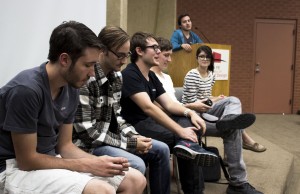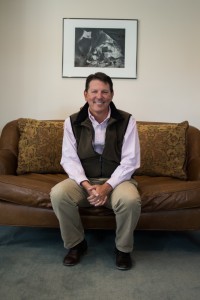Tags
Related Posts
Share This
HLC Visit

Student Voice President Shuford (far right) says the HLC visit is nothing to fear: “As someone who works in the student life section…I really appreciate how open the school is to any concern…”
“The university is still a baby,” says Student Voice President Rachel Shuford, reflecting on the Santa Fe University of Art and Design’s birth in 2010 and its upcoming visit from the Higher Eduction Commission (HLC) next week. “It still has a lot of growing to do,” Shuford says, “and HLC is here to help us.”
Five years ago, when the College of Santa Fe was just morphing into today’s SFUAD, an appointed team of faculty from various universities, under the guidelines of HLC, visited the school to examine its academic credibility. According to HLC’s Guiding Values, a school is credible (able to award degrees rather than academic certificates) when it demonstrates a focus on student learning; demonstrates that it’s an education system with a public and global purpose; when it shows continuous improvement; when it demonstrates integrity, transparency and ethical behavior; when its governing board works for the well-being of its student body; and when it proves it’s academically and financially sustained.
A new university in 2010, SFUAD of 2010 was given a list of what President Larry Hinz calls “recommendations”—improvements that SFUAD would have to confront before HLC’s next visit.
“We have changed so much since then,” says President Larry Hinz who has—along with staff, faculty and the student body—been preparing for the new commission’s team arrival Feb. 9.
In 2010, Hinz explains, HLC was “concerned about the [school’s] transition so they asked for a number of interim reports that we were to file with them, which we’ve been doing for the last five years.”

SFUAD President Larry Hinz encourages students to attend the open forum at 2:15 p.m., Tuesday, Feb. 10 at the Forum.
Jackalope file photo by Luke Montavon
As a result of those progress reports and strategic plans. “…it’s not as if they’re coming here for the very first impression five years later,” Hinz says. “They’ve been up to speed and we’re hopeful that we get another really good visit.”
In a series of class visits, open-forums, individual interviews and tours of the school, the new commissions team (made up of four individuals) will be examining SFUAD and making an updated assessment for 2015.
Along with these scheduled meetings and tours, the student body is especially invited to speak freely to HLC in an open forum this Tuesday, Feb. 10 at 2:15 in the Forum.
“The forum,” President Hinz says, “is an opportunity for two things. One, for the site visit team to meet our students, to hear what they have to say, and for students to meet the site visit team and to be able to ask questions. It’s a reflection of how interested and excited students are about the school so it would be really nice to have a really good turn out for that.”
Student Voice President Shuford also encourages participation from the student body in the forum, emphasizing that the commission’s visit is not something to be scared of.
“They’re not here to ruin the school,” Shuford says, “they’re here to make sure that things are happening the way the students like them to be [happening] and [to make sure] that this is an appropriate environment for artists to grow. [B]e honest if you have an interview with them and they ask you a question. Don’t feel that the school is breathing down your neck. You’re allowed to express your opinion.”
Student Voice Vice President Brian Seigel agrees with Shuford, saying that the commission “are people who are taking time off of their jobs at different colleges to pretty much share their experiences, perspective and ideas with other institutions. With HLC it’s not so much a thing of detriment, ‘oh no, what if we don’t pass?’ We’re going to be contractually obligated to improve,” Seigel says. “That’s pretty much what HLC is. We’re going to have to make things better—even things that are already good.”
And along with students who feel confident in the improvements of SFUAD in the last few years, Co-chair of the Creative Writing and Literature Department Dana Levin also expresses her approval of SFUAD’s growth saying that “in the face of growing pains of all kinds, faculty remain engaged and invested in the creative development of students.”

Creative Writing Co-Chair Dana Levin, who taught at the former College of Santa Fe, remarks that the growth of quality students at SFUAD is “impressive.”
After her time away from the College of Santa Fe, where Levin taught for 10 years, Levin returned in 2011 to SFUAD where she says she observes a better quality of student every year.
“More talent, more dedication to the work in their majors,” Levin says, and adds that “for an art school to grow in five years [from] 100 plus to over 900 students–students of quality—is impressive.” She observes also that SFUAD has done a terrific job of “connecting students and campus to the larger Santa Fe community, a community that had been dubious about this ‘new outfit’ that took over the College of Santa Fe back in 2009. Curriculum remains strong,” Levin says, “and there’s more investment in keeping arts curriculum current and relevant to students coming of age in the 21st century.”
When asked what they would want HLC to know about SFUAD 2015, Student Voice President Shuford says that she would emphasize how “open” SFUAD is compared to other universities. “As someone who works in the student life section,” Shuford says, “I really appreciate how open the school is to any concern or anything that a student has, and that things like gender-neutral restrooms or gender-natural halls was never a question.”
As far as the big test of credibility next week goes, Shuford says she’s not worried about SFUAD getting accredited and essentially passing the HLC test. “It feels like the school is slowly settling into its own skin,” Shuford says, “and realizing what it’s good at.”






 Jackalope Magazine is the student magazine of Santa Fe University of Art and Design. Building on the interdisciplinary nature of our education, we aim to showcase the talent of our university and character of our city.
Jackalope Magazine is the student magazine of Santa Fe University of Art and Design. Building on the interdisciplinary nature of our education, we aim to showcase the talent of our university and character of our city.
Recent Comments